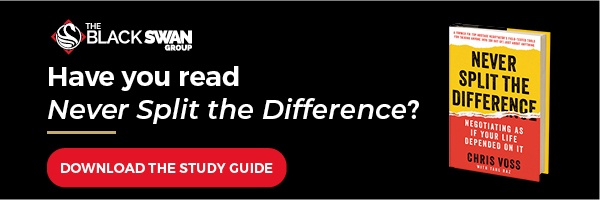Matt Jacobson, Facebook’s head of market development, recently gave a piece of advice for relationship success that likewise is fundamental to the Black Swan approach to negotiation. He underscores the concept that great relationship building is part and parcel to great negotiation.
Jacobson wrote a piece for the Hollywood Reporter about how to make a great impression and what to expect from a business meeting in Silicon Valley (the “Valley”). He talks about clothing expectations (don’t wear a hoodie) and office expectations (meetings start on time – shocking!).
He then delivers this:
“Seasoned Valley visitors have learned that listening first and understanding what matters to the other side engenders the most good will.” -Matt Jacobson, Head of Market Development at Facebook
Great negotiation is great relationship building. It’s what effective businesspeople use to make rain. Let’s dig into it.
There are two key components to this: listening and understanding.
The importance of both can’t be overlooked. Just like the simple molecule for water, (H2O) without either component you don’t have water. You can’t double-up on one to make up for the lack of the other.
There are two distinct phases here.
Phase #1: Listening
Trigger the information flow of what to listen for.
Start with pre-selected open-ended questions that you will use over and over because they are so good.
Jacobson gives 2 examples of perfect open-ended questions to lead off with: “What is most important to you?” and “What business problems can we help you solve?”
“What” and “How” open-ended questions are the platinum level questions. You can pretty much eliminate the rest of the interrogatives (who, when, where & why) for 90% of the conversation. Closed-ended questions (those that start with a verb – “do” “does” “is” etc.) get closed-ended answers.
Always ask your “What” and “How” questions driving at the same issues in twos or threes. Notice Jacobson gives us two great ones. I’d add “What’s the biggest challenge you face?” to this group.
Phase #2: Understanding
Nail this part with effective clarification: LMS – label, mirror, summarize – eliciting a “that’s right”.
Here’s the negotiation insider’s secret to the second part – showing you actually understand is even more important than caring because while it’s nice if you care, if you don’t understand, you can’t help.
A label is a statement or an observation that starts off with “It seems like…” or “It sounds like…” or “It looks like…” followed by your silence so they can respond. These are critical and your business partners will love that you are paying attention. Please don’t let the simple elegance of these cause you to underestimate the effectiveness of simplicity.
Mirror: Any words, terms, or ideas you’re not clear on, simply repeat the 1-3 critical words you need to clarify. Just 1-3 words; and word for word. This is the FBI hostage negotiation skill of mirroring and it is magic. You’ll love having people expand on ideas when you use this.
Summarize what they’ve said. If you don’t get a “That’s right” (word for word) you’re off track and you don’t have a green light to proceed. We’ve got a saying “That’s right = green light”. Proceeding without “That’s right” is the equivalent of crossing a railroad track with the yellow light flashing – you might be OK, but it’s kind of devastating when you’re not.
Follow this communication/negotiation advice and you know what? They’ll forget you have a hoodie on!
Make it rain!
